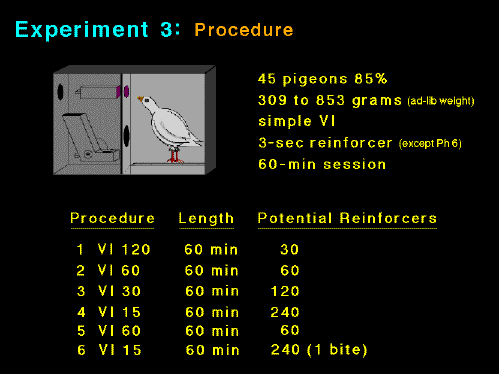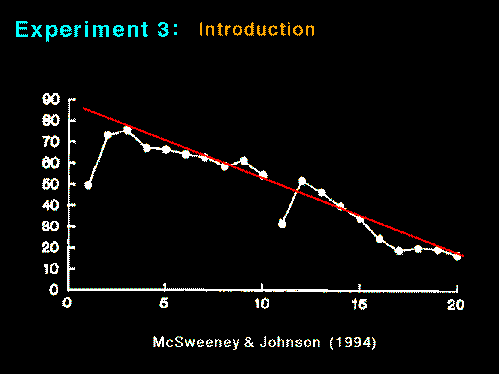 Figure 29
Figure 29


 Figure 27
Figure 27
It occured to us that the bitonic effect could be what is labeled as satiation or food handling capacity.
It may be that an animal's food handling capacity could be exceeded even if daily homeostatic repletion were not accomplished. For example, when McSweeney and Johnson carried out two contiguous sessions, the major portion of the within-session rate change appeared to be a continuous function across both sessions.
This hypothesis is given support by the number of reinforcers in a typical schedule which has been reported to show a strong within-session effect. For example, VI 15 sec x 1 hr = 240 5-sec reinforcers for an animal maintained at 85% ad lib.
Experiment 3 was implemented to explore the effect of the amount of food provided in a daily session on the within-session effect. 45 pigeons which were maintained at 85% of their ad lib weight were run in fixed 60-min sessions. The bird's body weights varied from 309 to 853 grams. Phases lasted about 30-40 sessions.
The procedures simply increased the reinforcement rate (thereby increasing the amount of food per session). The final phase provided a high reinforcement rate, but limited the amount of food delivered per session by limiting the reinforcement duration to one bite (photocell detection).
The median single line slope for the 45 birds under each of the procedures are provided in the left column. Overall, there was a modest and similar decline under all procedures with the exception of the VI 15-sec schedule. When the amount of food provided by a VI 15-sec schedule was limited, it did not show a sharp decline across the session.
The larger birds did not show as sharp a decline under the VI 15-sec schedule as did smaller birds. The r2 for weight against slope was 0.20. The bird's body weight was also related to the slope under the VI 60-sec schedule.
The initial slopes were similarly positive with the exception of the VI 15-sec schedule which was negative. The bird's body weight was not related to the slope.
The second segment lines were again similar with the exception of the VI 15-sec schedule. The VI 15-sec and VI 15 one byte procedures had a different effect on the within session rate change. The weight of the bird was related to the slope under the VI 30, VI 15, and VI 15 one byte procedure.
A similar effect was apparent in McSweeney's rate loss parameter.
In order to compare the relative abilities of each of three models (2 straight line, McSweeney, and Killeen) to account for the within-session rate change, the following analysis was carried out. The residual error from each model for a bird was subtracted from the residual error for a straight line fit for that bird. This "gain" was then plotted in that models' column in the frame for that schedule. The resulting data points depicted how well that model did as compared to a simple straight line for the 45 birds under that schedule.
This figure presents that analysis. It shows all three models were very similar. In general, the two straight line was superior. Note the change in Y axis scale for the VI 30-sec and VI 15-sec schedule. The third quartile for each model for each procedure is designated with a red bar.


Date Last Reviewed : January 6, 2002